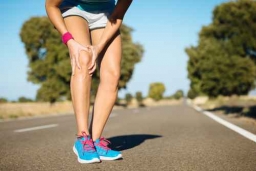Patellofemoral Pain Syndrome: A Pain in the … Knee!
Wednesday, September 28, 2016 - 09:00

One of the most common injuries people suffer from is pain around the knees. For those who participate in sport or physical activity this is even more of a standard occurrence. If you feel pain in the front of your knee, or around the kneecap you main be experiencing Patellofemoral Pain Syndrome (PFPS). PFPS is also often referred to as Runner’s Knee or Jumper’s Knee since it is a common injury for people engaged in sport. It generally occurs when nerves sense pain in the soft tissues and bone around the kneecap.
Causes
There are a variety of things that may contribute to the development of PFPS. Two of the main causes are usually attributed to overuse or misalignment.
- Overuse:
This generally refers to physical activities that are rigorous and that put repeated stress on the knee or any sudden change in physical activity (frequency or intensity)
- Misalignment:
This refers to abnormal tracking of the kneecap in the trochlear groove which may cause increased pressure between the back of the patella and the trochlea, irritating soft tissues. Factors that contribute to this are: (1) Problems with the alignment of the legs between the hips and the ankles; and (2) muscular imbalances or weaknesses especially in the quadriceps muscles at the front of the thigh.
Other causes of PFPS may be improper technique, improper use of equipment, changes in footwear or changes in playing surfaces.
Since women are 4 to 6 times more likely to experience knee injuries than men, they are also more susceptible to PFPS. This is due to the tendency of women to have an imbalance in the strength ratio between with quadriceps muscle and their hamstring muscle and the fact that women initiate movement from their knee where men move from their hip.
Signs or Symptoms
- Pain behind or underneath your kneecap or pain below the knee cap
- Pain may be in one knee or in both
- Often described as a dull, aching pain in the front of the knee, however pain can also be sharp at times
- Pain during exercise and activities that repeatedly bend the knee, such as climbing stairs, running, jumping, or squatting
- Pain when sitting with your knee bent for a long time
- Popping or crackling sounds in your knee when climbing stairs or when standing up after prolonged sitting (locking is not a sign and may suggest another issue)
Treatment
Consulting a medical professional is an important first step in order to correctly identify the cause of the pain you are experiencing. If Patellofemoral Pain Syndrome is your diagnosis, symptoms can often be relieved with a simple treatment plan such as changes or reductions in activity levels and/or a therapeutic exercise program (physical therapy).
- Switching to low-impact activities that put less stress on the knee joint, cycling and swimming are good options. Depending on your case, complete rest may also be recommended.
- Putting ice on your knee for 20 minutes at a time, several times a day can help reduce pain symptoms.
- Following a physical therapy program. This type of program may include exercises to make your muscles stronger and increase flexibility. Exercises may concentrate on certain muscle areas so as to reduce strength imbalances.
- Taping the knee, using a brace with a hole around the kneecap, or using shoe insoles can be helpful for some people.
- Non-steroidal anti-inflammatory drugs (NSAIDs) can help reduce swelling and relieve pain.
- Most people with PFPS do not need to have surgery, but it may be recommended in serious cases.
Patellofemoral Pain Syndrome affects people in a variety of way and it may take weeks or months of treatment for the pain to go away. If pain persists for an extended period, it’s time to check back in with your doctor.
Prevention
Unfortunately Patellofemoral Pain Syndrome can come back. The good news is that by following a few simple recommendations, the risk of recurrence can be reduced.
- Keep your knee joint strong and flexible, with particular focus on the quadriceps and hamstring muscles.
- Wear shoes that are appropriate to you activity and replace them regularly so they don't get worn out.
- Make sure to warm up sufficiently before activity, incorporating stretching and flexibility exercises.
- Increase training load gradually.
Patellofemoral Pain Syndrome does not have to hold you back from being active. Being aware of some of the most common causes of knee pain and how to manage and prevent it can go a long way to keep you on the playing field.
References
Pattellofemoral Pain Syndrome. American Academy of the Orthopedic Surgeons. Retrieved from the Internet September 21, 2016.
Patellofemoral Pain Syndrome (Runner's Knee) Treatment. Johns Hopkins Medicine. Retrieved from the Internet September 21, 2016.
Osborne, M. Why Do Females Injure Their Knees Four to Six Times More Than Men…And What Can You Do About It? University of Colorado Hospital. Retrieved from the Internet September 21, 2016.
Dixit S, Difiori JP, Burton M, and Mines B. (2007) Management of Patellofemoral Pain Syndrome. American Family Physician, 75(2):194-202.